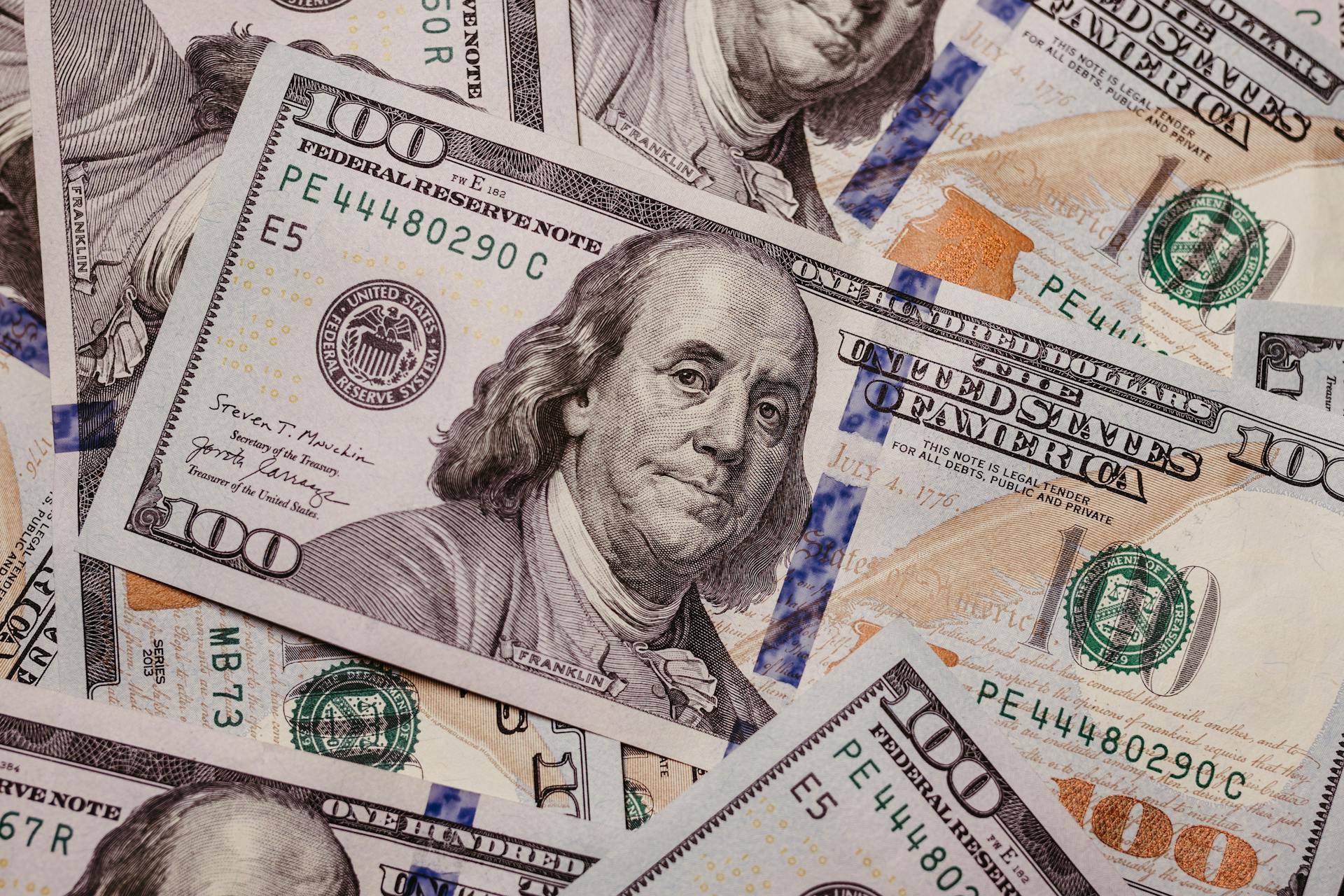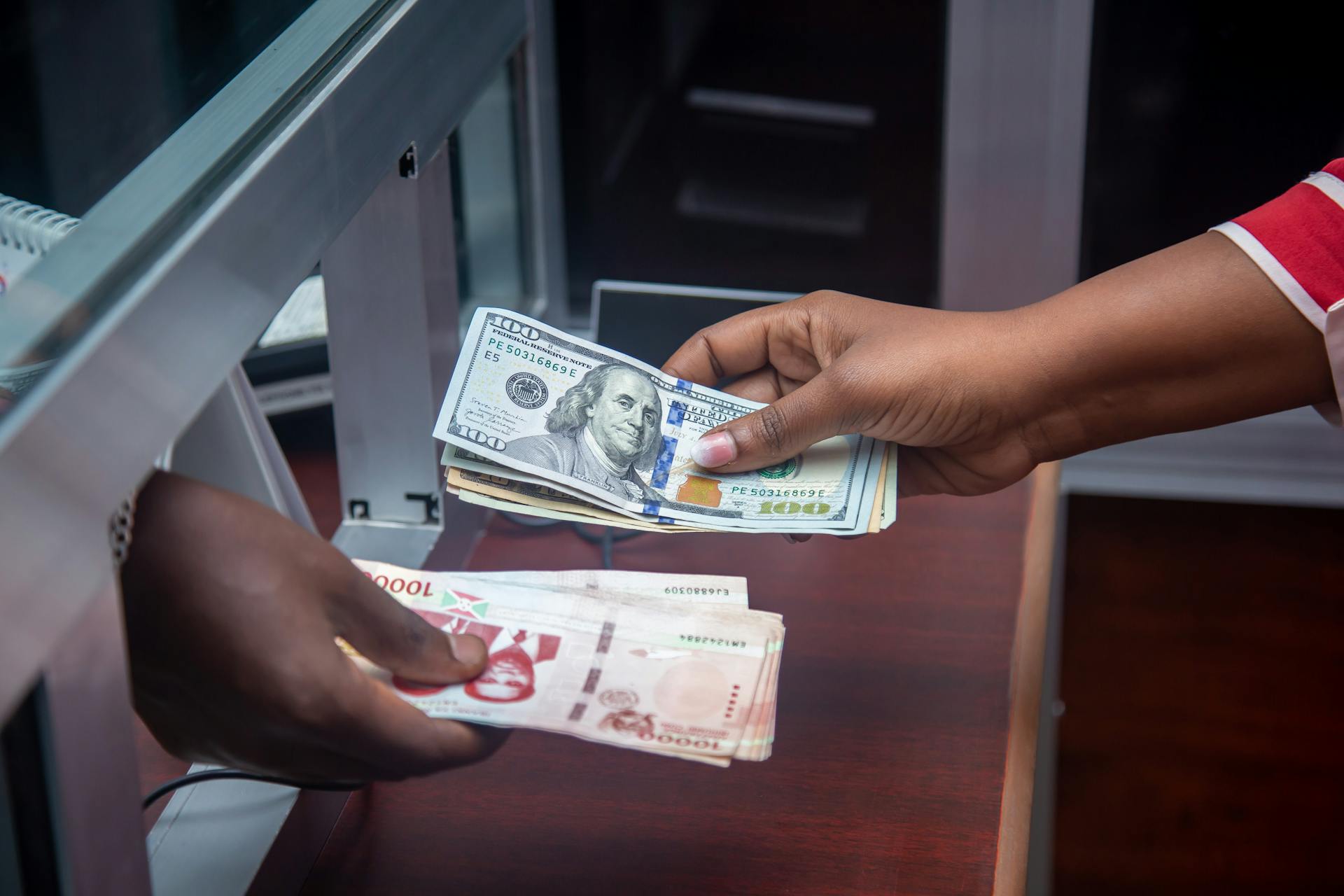
The Guyanese dollar is the official currency of Guyana, a country located in South America. It's also known as the GYD.
The Guyanese dollar is subdivided into 100 cents. This might seem straightforward, but it's essential to understand when dealing with local businesses or exchanging currency.
You can find Guyanese dollars in various denominations, including $20, $50, $100, $500, and $1,000 notes. These notes feature images of notable Guyanese figures and landmarks.
Recommended read: Zimbabwean Bond Notes
History of the Guyanese Dollar
The Guyanese dollar has a rich history that spans centuries. It's a currency that's deeply rooted in the country's colonial past, with influences from various European powers, including the Dutch, French, and British.
In the early 17th century, the Dutch territories of Essequibo, Demerara, and Berbice on the north coast of South America came under British control. This marked the beginning of the British West Indies dollar, which was introduced in 1839 as a unit of account to facilitate the introduction of British sterling silver coinage. The dollar unit was equivalent to 4 shillings 2 pence sterling and replaced the guilder unit at a rate of 1 dollar = 3+1⁄8 guilders.
Consider reading: British Currency Quid Pound
The British introduced a British variety of the Dutch guilder currency, but it was later replaced by the Spanish dollar as a unit of account. Spanish, Mexican, and Colombian silver dollars continued to circulate alongside the British sterling coinage until 1876 when these dollar coins were demonetised.
In 1888, a special request was made for groats to be struck for use in the British West Indies and British Guiana. These coins were first struck in 1891 and continued to circulate until 1917, when they were struck exclusively for use in British Guiana.
Here's a brief overview of the denominations of the Guyanese dollar over the years:
- 1839: Dollar unit introduced, equivalent to 4 shillings 2 pence sterling
- 1876: Spanish, Mexican, and Colombian dollar coins demonetised
- 1891: Groat coins first struck for use in the British West Indies and British Guiana
- 1917: Groat coins struck exclusively for use in British Guiana
- 1966: Guyana gained independence and started circulating new coins and banknotes
Today, the Guyanese dollar is issued in various denominations, including banknotes and coins. The central bank issues the currency in the following denominations: $20, $50, $100, $500, $1,000, and 5,000, as well as coins with denominations of $1, $5, $10, and $100.
A fresh viewpoint: 5 Kronur
Guyanese Currency Types
Guyanese currency has a rich history, with various types of notes being introduced over the years. Private banknotes were first introduced in the late 19th century by the British Guiana Bank and the Colonial Bank.
The British Guiana Bank issued notes until 1907, while the Colonial Bank issued notes until 1917. The Colonial Bank was taken over by Barclays Bank, which issued notes in denominations of 5, 10, 20, and 100 dollars between 1926 and 1941.
Local notes were replaced by BWI$ notes in 1951, and later, the East Caribbean dollar (EC$) replaced the BWI$ in 1965. The East Caribbean dollar circulated in British Guiana for a year until the Guyanese dollar was introduced in 1966.
The Guyanese dollar was introduced in 1966, replacing the East Caribbean dollar at par. This marked a significant change in the country's currency system.
New banknotes were introduced in 1965, featuring denominations of 1, 5, 10, and 20 dollars. A second series of notes was issued between 1988 and 1992, featuring 20, 100, and 500 dollar denominations.
The 1996–1999 series of notes included 20, 100, 500, and 1000 dollar denominations. The 2000–2002 series included 500 and 1000 dollar notes.
New banknotes of 100 and 1000 dollars were issued on 29 March 2006, featuring updated designs and security features. The 2011 issue included 500 and 1000 dollar notes with brand new security features.
In 2013, the Bank of Guyana unveiled the 5,000-dollar note, which was issued on December 9.
Take a look at this: British Money Terms
Understanding the GYD
The Guyanese dollar, or GYD, has been the official currency of Guyana since 1965, when the country gained its independence from the United Kingdom.
The Guyanese dollar debuted in 1839 as a transitional currency from Dutch guilders to British pound sterling, and it has undergone changes since then.
You can exchange your money for Guyanese dollars at banks, hotels, and foreign exchange offices, also known as cambios, which usually offer better exchange rates.
The Bank of Guyana is responsible for monetary and fiscal policy in the country, as well as the printing and maintenance of the dollar.
The bank issues notes in G$20, G$50, G$100, G$500, G$1,000, and G$5,000 denominations, and coins are minted in G$1, G$5, G$10, and G$100 denominations.
A single Guyanese dollar is worth around US$0.0048 as of December 21, 2023, which is why it takes about G$210 to get just over one full US dollar.
Hard currency is heavily circulated within the country, making it a good idea to have cash on hand, especially outside of major tourist areas in Georgetown.
A unique perspective: 1 850 000 Krw
Exchange Rates and Conversion
The Guyanese dollar, or GYD, is a unique currency that doesn't have a fixed exchange rate, unlike some other countries. This means the exchange rate between the GYD and other major currencies like the US dollar or Euro can fluctuate based on market conditions.
Typically, 1 USD is equivalent to around 200 GYD, but this rate can vary. It's always a good idea to check the current exchange rate before making any large transactions or travel plans.
The exchange rate between the US dollar and Guyanese dollar is relatively stable, with a single Guyanese dollar being worth about $0.0048 as of December 21, 2023. This means it takes about G$210 to get just over one full US dollar.
If you're sending money to or from Guyana, using a currency converter can help you quickly estimate the exchange rate. You can find these converters online or through apps.
It's worth noting that the Guyanese dollar is not widely accepted outside of Guyana, so it's a good idea to have some US dollars on hand, especially if you're planning to travel to major tourist areas.
Discover more: Banking in Guyana
Key Information and Tips
The Guyanese dollar is the official currency of Guyana, abbreviated as GYD and represented by the symbols $ and G$. Banknotes are printed in various denominations, including G$20, G$50, G$100, G$500, G$1,000, and $5,000.
The Bank of Guyana is responsible for printing and maintaining the dollar. Coins are minted in G$1, G$5, G$10, and $100 denominations. Having smaller denominations can be handy for tips and small purchases.
It's a good idea to exchange money wisely by using authorized exchange bureaus or banks to get the best rates. Be cautious of counterfeit notes by familiarizing yourself with the security features of Guyanese banknotes.
For another approach, see: 32 000 Грн
Key Takeaways
The Guyanese dollar is the official currency of Guyana, abbreviated as GYD and represented by the symbols $ and G$.
The Bank of Guyana is the country's central bank and is responsible for printing and maintaining the dollar. They handle the production of banknotes and coins.
Banknotes are printed in various denominations, including G$20, G$50, G$100, G$500, G$1,000, and $5,000.
Coins are also minted in different denominations, such as G$1, G$5, G$10, and $100.
For your interest: Send Money to Guyana
Tips for Tourists

As you prepare for your trip to Guyana, it's essential to understand the local currency and how to handle it wisely. Exchange money at authorized exchange bureaus or banks to get the best rates.
Carrying small denominations of Guyanese currency can be super handy for tips and small purchases. Having a mix of larger and smaller bills will make your transactions smoother.
Be cautious of counterfeit notes, and take some time to familiarize yourself with the security features of Guyanese banknotes. This will help you avoid any potential issues.
In some areas, especially rural regions, cash is still the preferred payment method. Be sure to keep some cash on hand for small vendors and local transactions.
You might like: A Depreciation in the Domestic Currency Will
Economic Impact and Future
Guyana's economy is heavily reliant on sectors like agriculture, mining, and oil production, which can significantly impact the value of the Guyanese dollar.
The discovery of oil fields in 2015 by Exxon Mobil Corp. has been a major game-changer for Guyana's economy, with 17 more oil fields discovered over the next five years and now a total of 30.
The International Monetary Fund predicted Guyana's economic growth could reach close to 60% this year, making it one of the few economies experiencing GDP growth in 2020 despite the pandemic.
Changes in commodity prices, international trade, and foreign investment can affect the exchange rate and overall value of the currency, highlighting the importance of monitoring these factors.
The IMF also notes that Guyana's real GDP is expected to grow 20% per year through 2028, driven by the country's offshore oil reserves.
Government policies, inflation rates, and fiscal measures also play a significant role in determining the strength of the Guyanese dollar, emphasizing the need for careful financial management.
The recent developments in the oil and gas sector are expected to boost the country's economy and could lead to increased foreign investment, strengthening the Guyanese dollar and enhancing overall financial stability.
Consider reading: How to Invest in the Iraqi Dinar
Featured Images: pexels.com


